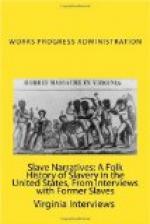Only one of the three Wamble boys joined the southern army. Until the war was over, the other two boys who refused to go to war hid out in the surrounding woods and hills. The only time the Reverend’s father left the farm was to attend his master Billy, when he was in a hospital recovering from wounds received in battle.
Wamble was a wagon-maker, and he made two or three wagons which usually took about six months. Then he hitched teams to them and went north to Missouri, Kansas and Arkansas and kept going until he had sold the wagons and teams, keeping one wagon and team, with which to return home. Some times the master would be gone for a period of nine to twelve months. During his absence the Reverend’s grandfather was in charge of the farm.
The grandmother of Rev. Wamble was a full-blooded African negro, brought to this country as a slave at seventeen years of age. She was a very large and strong woman and was often hired out to do a man’s work. Slaves were forbidden to have papers in their possession and since they were forbidden to read papers, hardly any slaves could read or write. There never was any occasion or need to do these things. It was not known that the Reverend’s grandmother could read and write until after the Civil War. The Reverend remembers his grandmother bringing an old newspaper to his hide-out during the Civil War, late at night, after the Wamble family had retired, and making a candle from fried meat grease and a cord string, which made a very tiny light. She placed some old blankets over the walls so that no light could be seen through the cracks in the hut. She would then place the paper as near as possible to the light, without burning it, and read the paper. It was never discovered where or how she learned to read and write.
If a young, good-looking, husky negro was trustworthy, the family would make him the driver of the family carriage. They would dress him in the best clothes obtainable and with a silk-finished beaver skin hat. The driver sat on a seat on the top and towards the front of the carriage. He was compelled to stay on this seat when waiting for any of the family that he might be driving, regardless of the weather or the length of time that he had to wait.
The mail was carried in the same kind of vehicle with negro drivers. In each town there was a certain rack at which this mail carriage would stop in each village or wherever the designated stop was made. Upon nearing the rack and coming to a stop, the driver would blow a bugle call which could be heard for miles around, and people hearing this bugle would come and get their mail. The Reverend remembers that several of these drivers froze to death during the cold weather, and that in the winter, many times the horses on the mail carriage upon coming to this rack would stop, and the driver would be sitting frozen to death in his seat.
Men would take him down, carefully saving the silk beaver-skin hat for some other driver.




